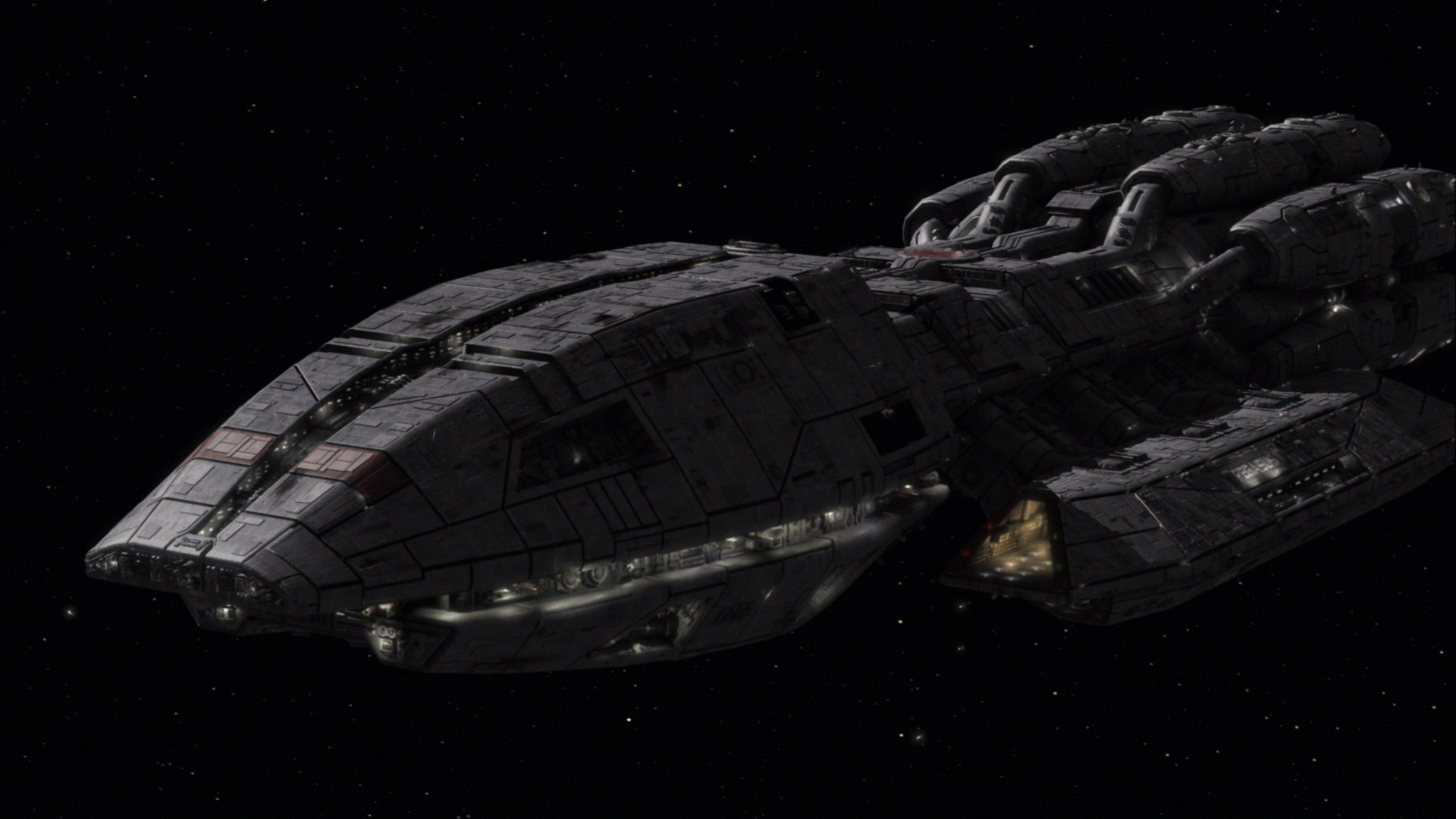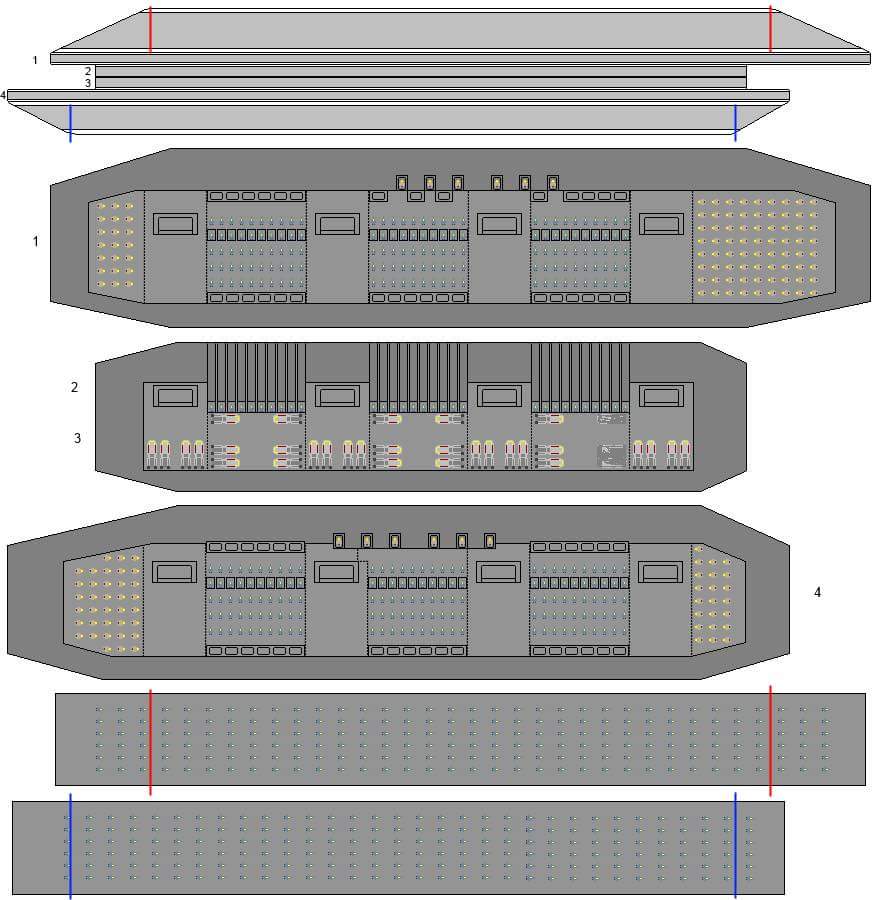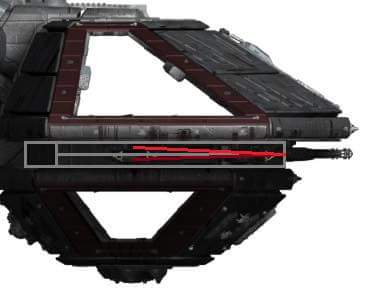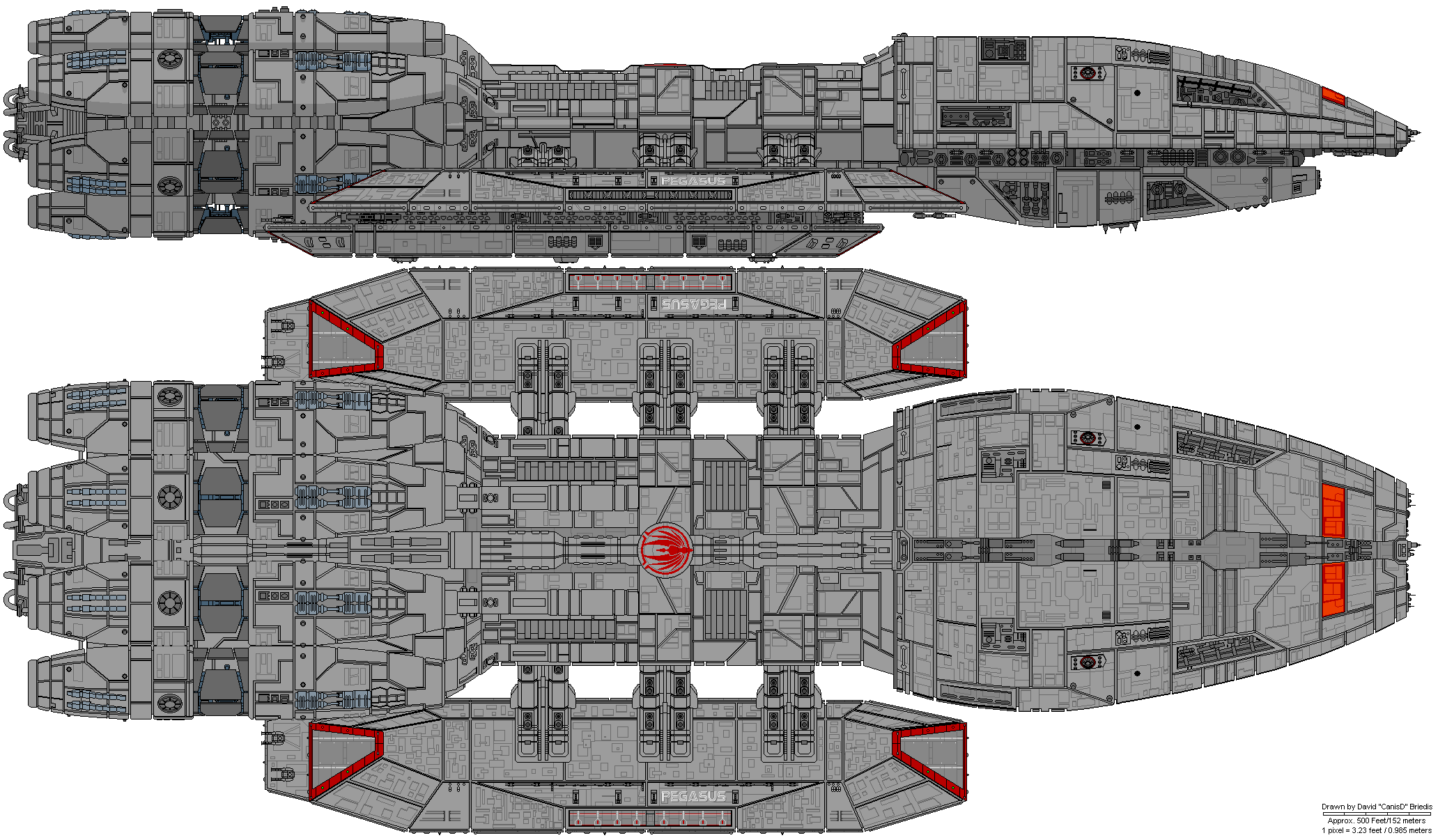| PEGASUS-Class Surveillance Ships |
|---|
 | | Fraction: | Kobolese/UGC/Other. |
|---|
| Type: | Sureveillence. |
|---|
| FTL: | Yes. |
|---|
| Crew: | Apx. 2500 (full crew) |
|---|
| Role: | Law Enforcement Sureveillence/RDF fighter launch and support platform/cruiser. |
|---|
| Weapons: | 34 Primary M-14 Rail Launchers (30 twin turrets, 4 fixed twin mounts);80 Defense Laser Batteries;20 Missile Batteries. |
|---|
| Small Craft: | L/E Raptors;Regional RDF Veritechs;Regional RDF Aero-Space Fighters. |
|---|
| Status: | Active. |
|---|
| Dimensions: |
|---|
| Length: | 5,872 feet 8½ inch. |
|---|
 | Standard Kobolese Empire-Era
Flight Deck Arrangement. |
|---|
 | Recovery And Launch Arrangement
(starboard aft view). |
|---|
 | | Dorsal And Starboard Abeam Views. |
|---|
 | | A Very Rare PEGUSUS-Class In Direct Action. |
|---|
The PEGASUS-Class is an advanced intelligence collection ship designed originally as a front-line battle carrier (like her older sister class the BATTLESTARS) by the Kobolese Royal empire; Colonial capital warship/carrier that served as the mainstay of the Colonial Fleet. They served as front ships of the line as well as command ships. Having been first introduced roughly twenty years following the end of the Cylon War, and while still considered top-of-the-line vessels, the fleet was just beginning the process of phasing the oldest examples out of service, in favor of the newer Block II's and the NOVA-Class, at the time of the Fall of the Twelve Colonies.Introduced years after the First Cylon War, the structural design of the PEGASUS class differs significantly from the original BATTLESTAR-Class. The "neck" section is smaller, and the PEGASUS class features eight sublight engine pods instead of the older class's six. Its edges are more angular, and the hull is more completely armored (no exposed ribs). Each flight pod consists of two stacked landing bays with adjoined decks and hangars, which along with computer-assisted landings results in a faster Viper recovery rate. Each flight pod also has Raptor landing bays on the sides, allowing for rapid transfer of crew cargo when docked. These pods are fixed and do not retract when executing an FTL jump, suggesting advances in jump systems. Inside, the class features automated sliding doorways, basic computer recognition stations in vital areas, and networked computer systems.They are fitted with heavy armament including bow mounted cannons and multiple heavy turrets spread throughout the hull and flightpods. Gun batteries on the PEGASUS class are distributed all over the ship, with the greatest concentration of large turrets found along the side of the ship, within the valley created by the upper and lower halves of the hull, and along the flight pods. Four are mounted on the underside of the upper hull on the ship's bow, below which sits four non-turreted large guns; these form the main forward batteries. Six turrets are mounted on each underside of the alligator head, grouped in pairs. There are also three turrets on the side of each flight pod along two more turrets are mounted on the front and back of each flight pod. This amounts to a total of thirty-four main gun batteries. The turreted guns of the PEGASUS class have a higher rate of fire than a BATTLESTAR'S turreted guns when operating in flak mode.There have been 3 production runs of the PEGASUS, each slightly different from the others.Block IThe original production run. Entering commission 20 years after the end of the Cylon war, and representing a revolutionary shift in the design of colonial warship, the PEGAGUS' were the most powerful warships ever created.The Block I was the first production class of battlestar to feature non-retracting pods. Physically they were distinct from latter examples due to the completely overlapping flight pods. This also meant that they carried a smaller air-wing and had worse arcs of fire, but did provide greater structural soundness.Eventually the entire block underwent a massive refit that greatly improved the offensive capacity and saw many used to test experimental systems. The refit included the addition of spine mounted cannons and heavy missiles, both additions that would be incorporated in the Block II.At the time of the Second Cylon war the Block I's were being phased out and replaced with Block II's and in the case of the ATLANTIA, the NOVA-Class.Block IIBy far the most numerous production run, the Block 1I showed a massive upgrade on the block I's. With slanted pods allowing cannons better arcs of fire and an increased air-wing the offensive power was much improved; In addition, the computer systems were far more advanced, and the Block 1I's were the first to be designed specifically to be operated using networks, unlike the Block I's which had treated them as more of an added luxury. This meant the crew could be massively reduced.Block IIIThe final rendition of the class the Block III was still in production at the time of the UGC's Annexation with only a few in active use. Much like the improvements of the Block II over the Block I, the Block III featured updated and additional weapons, armor, and a much greater launch capacity. They also included many of the systems trialed in the refitted Block 0's. These are the main block currently in service."Block IV"The proposed "Block IV" PEGASUS-Class were to have been built with 4 flight pods that could be partially retracted to the hull for FTL flight (each one being a direct inversion of the other externally, clone internally). One such, the HELENA CAIN (BS-62), was on the ways and nearing completion when The Advent occurred. Her Commanding officer, Commander J'Haac FISK, ordered the incomplete ship underway to fight the invaders, and she was very badly damaged at The Encounter At Molokai (which went very badly for Kobolese 5TH Fleet, the CAIN being the only one to escape in any fashion) with a loss of 700 crewmen.The CAIN was repaired and finished after the surrender, but the UGC took a relatively dim view of the design, and no others have been produced for the Spacy, but some RDF's have taken them in limited numbers for internal security purposes; The CAIN maintains station of Scorpia as part of the Scorpian Regional Defense Network.CapabilitiesThe PEGASUS-Class is highly automated and features networked computer systems to allow rapid calculations and response time. They can also manufacture all the replacement parts needed for Raptors and Vipers, as well the frame and outer skin of these ships (only compoenets compatible with one of these two are produced for Vaiders). This makes them completely self-sufficient in regards to fighter repair and replacement. They also have advanced food and water reclamation machinery, in addition to food production facilities making them able to be self-sufficient for five years before having to resupply and recharge their systems.An important advancement with the PEGASUS-Class was the launch and recovery bays; On the BATTLESTAR-Class, there is only one recovery bay per flight pod, with the void below this serving as a refueling and rearming area, whereas on the PEGUSUS-Class there are TWO recovery bays, with both serving the refuel/rearm necessities, joined by a rotational hatch that allows fighters, shuttles, etc. in either bay to be "flipped over" into the opposite bay if necessary, while both are joined to the main hanger via an independent passageway (fighters etc. from the lower bay being rotated 180 degrees axially en route to the hanger using the same technology used in rail launchers, but at vastly reduced speed- it's also this passageway that crew members normally use to transit between the hanger and underside recovery bays, orienting them to the deck en route).Air WingThe PEGASUS-Class held considerably more small craft than the PEGASUS-Class which had preceded it. Although the exact number varied with each successive block, and each vessel was able to handle significantly more than it's normal operational load out, even the smallest standard complement of small craft was larger than any other class (until the introduction of the NOVA-Class) could operate. The wartime air wing of a PEGASUS was twice the size of the peace time load. The number of shuttles carried is unknown.Block IWhen first conceived the PEGUSUS-Class was expected to have twice the capacity of a GALACITICA-Class; This was reflected in the air wing of the Block I, originally standing at 160 Vipers divided between 8 squadrons and supported by 40 Raptors. However, overtime this has changed, with each individual ship being differently out fitted, to the point that only the ETERNAL retained the original air wing size at the time that the ATLANTIA was launched. Viper squadrons were coded blue, red, green, yellow, orange, purple, black and white.Block IIA typical Block II vessel carried a peacetime load of 200 vipers, 2.5 times that of the PEGASUS. These were broken down into 10 squadrons of 20 vipers a piece, with two of these squadrons serving in a reserve role. In addition they carried around 50 Raptors. Squadrons were coded blue, red, green, yellow, orange, purple, black, white, and reserve squadrons gold and silver.Block IIIWith hugely expanded hangar facilities when compared to the Block I or II, the Block III was able to carry an air wing almost as large as a NOVA-Class ship. The standard air wing was a whole 100 vipers more than the Block I. Split into 15 squadrons of 20 vipers, of which 4 were reserve squadrons, the standard air wing included an enormous 300 vipers. On top of this there were still 50 Raptors but also a squadron of 25 Scimitars rounded off the air wing. Viper squadrons were coded blue, red, green, yellow, orange, purple, violet, brown, black, white, grey, and reserve squadrons gold, silver, bronze and Platinum.FateThe Advent changed the strategic situation significantly; The Kobolese no longer needed a large, permenant standing army, therefore they no longer needed the warships that would support them. The PEGUSUS-Class were originally slated to be sold the REF, but the REF reported they could not and would not use them; The Patrol, always desperate for new ships, also could not take on these behemoths. The Galactic Investigation Services however found a use for them; Permenatly positions ships over planets of interest where UGC interests had been "adversely effected" by regional conditions- In other words, permanently watching UGC citizenry that might be plotting to overthrow the council's control. Considering that the UGC was still ass-deep in FBX 21555320 (though the evacuation plan was already drawn up and beginning), this plan fell upon receptive ears indeed.But it's not necessarily as easy said as done; For an official GIS assignment, a regional authority must first request same through the GIS' local office to the Headquarters; From here it has to be signed off on at the Regional Assignments Office, thence the Law Enforcement Information Office, then the GIS' Marshall, who routes it to the individual, not joint (Common), committees in both the Board and the Senate (actually, it gets signed off on at the Board, then forwarded to the Senate, with the Marshall's endorsement), at which point it gets signed or vetoed by the Chairman (or proceeded "pro form" by not being addressed in the 30 day period necessitated by law).A not uncommon alternative is simply to purchase one for the Kobolese by the regional or local authority, at which point she is the property of that authority, and in no way beholden to the UGC if not part of the Defense Forces. (Even if she is, it might not matter; The Spacy rarely tasks RDF ships to forward missions, usually taking Army and AeroSpace Forces instead.)The PEGASUS-Class are being considered as a replacement to the ARMOR-Class Space Carriers, but no such plans have been formally determined at this time; If this is made, the Spacy will probably take on the ships as a general purpose replacement for forward-deployed battlewagons (the T'sentraedi warships of lore and VEROCHA-Class Frigates are on their way out anyways, having never been meant to serve this long in any case, and are capable of supporting a quartet of ALLIANCE-Class Corvettes or a pair of ANDROMEDA-Class Medium Cruisers without significantly diminishing fighter wing capability, this making the majority of the Spacy fleet)."Strategic Issues"Blueprints for the PEGASUS-Class were released in the "normal course of business" by the Council, before it was realized that the PEGASUS-Class was basically an scaled up version of the BATTLESTAR-Class, giving literally anyone and everyone with galactic net access a chance to see into the workings of the infamous spy ships; Fortunately, many significant changes were made (the PAGASUS-Class' Office Of Deck/CO box is half the size of a BATTLESTAR'S entire bridge which doesn't even HAVE an OOD/CO box), but one in particular did "escape"; The PEGUSUS-Class uses abeam-oriented launch tubes (essentially the same as an L-22 rail launcher, not terribly surprising since the L-22's MRM's are only a little smaller than a Viper, as it requires the pilot's survival systems that a missile doesn't). While in and of itself inconsequential, it did inform the UGC's various enemies of how the fighters "can" be launched, giving them some opportunity to adjust. (Fortunately, all it really revealed for all intents and purposes was the EASE with which fighters could be launched, giving them a new reason to worry.)Name: PEGASUS-Class Surveilence ShipModel Type: Surveilance ShipCrew: Varies from 10,000 to 50,000.Passengers: Varies from 5,000 to 10,000.M.D.C. By Location: |
1. T'sentraedi Style Heavy Lasers (50): Still a highly effective design, it is an REF standard weapon throughout the fleet.
M.D.: 1D4 times 100 per blast.
Rate of Fire: Twice per melee.
Range: 200,000 miles.
Payload: Unlimited.
2. Automated Missile Battery: Each vessel is equipped with 12 of these missile turrets, two on each of her six main sides.
Missile Type: Any M.R.M. or L.R.M.
Purpose: Anti-Ship Defense.
M.D. and Range: Varies by type used.
Rate of Fire: Twice per melee.
Payload: Up to 1,000.
3. Defensive Laser Batteries (100): For anti-missile and meteorite defense.
M.D.: 5D6 per blast.
Rate of Fire: Per gunners attacks per melee plus bonuses (generally 4 or 5 per melee).
Range: 500 feet.
Payload: Unlimited.
| 4. RCIRS: The Remote Computer Information Retrieval System (RCIRS), called "the wrecker," is a system that allows a BATTLESTAR-Class to literally intrude into a computer database (from a monstrous building sized mainframe to a wristwatch) and retrieve any data files located within. The system is a bit "dumb," though, being able to retrieve data in binary mode only, and only to copy the data; It can't distinguish the nature of the data by itself, another systems has to translate it from 1's and 0's into useable information.Wreckers 'can' be defeated by having the system behind sufficiently hardened partitions, but 20 feet of steel-reinforced concrete is too expensive for most purposes, and even then has to be formed into a Faraday Cage to be fully effective. Wreckers "can" also remotely reformat the system, causing all data to be lost. They don't work on comuters that are shutdown, nor do they work on external data systems that aren't in use (making backups a good idea for those aware of the system, fortunately few).
5. Ships, Fighters, Power Armor, and Robots: These fluctuate wildly over time; Each individual mission has specific requirements and therefore the weapons platforms on board will be adjusted to those needs. However, the following is a GENERAL assortment:
Shuttles- 5
Space Fighters- 5,000
Guardian Fighters- 6,000
Veritech Fighters- 10,000
Destroids- 1,000
Veritech Cars- 1,000 |
- Full Stealthing: Along the hull are massive areas where what appear to be exposed frames are visible- Don't be fooled. These are sensory system traps, where ANY signal given off by the ship OR aimed at her are collected, bounced around, and absorbed. Less than one/one MILLIONTH of a percent of any signal will ever find it's way to the sender.
- Chameleon System: Pleizio-ceramic tiles darkened or lightened as necessary to render the craft invisible. Minimum effective distance: 2 feet.
- E.S.M.: Radar Detector. Passively detects other radars being operated.
- Radar: Combat grade radar. Range 1 million³ miles, can track up to a half million individual targets. 95% reliability (50% against unfriendly stealthed vehicles except each other).
- Blue Force Tracker: Identifies friend from foe. Overlays the information on both the radar and HUD, ensuring that friendly forces are not accidentally targeted.
- GPS: Standard tracking device. Ties into the Blue Force Tracker.
- Anti-Jamming System: Reduces Electronics Countermeasure by ¾ (decrease skill level appropriately).
- HUD: Displays maps, radar, targeting information, and any OTHER information the wearer wants directly in front of the user.
- FLIR/SLIR: Forward and Side Looking Infrared. Allows pilot to get visuals on targets at night.
| - Virtual Map: Displays a continuously-updating map of local terrain for the pilot. Takes data from and gives data to other friendly units in the area. Effective land navigation of 85% as updates come. Good to 500 miles. Specific range can be adjusted in 1 mile increments.
- 1-MC: Internal announcements.
- Telescopic Canadarm III's (over 40): Allows the crew to reach out into dead space and grab just about anything.
- Video Camera: Records from the HUD. 50 hours of recording available.
- Full range optic sensory suite: Infrared, ultra violet, Magnification, night sight, color filters, thermal imager.
Range is about 200 miles for MOST sensors. - Survival Pack: A pack of simpler emergency survival supplies: Pup tent, sleeping bag, black light, GPS, first aid kit (bandages, gauze, bandage tape, pads, antiseptic/analgesic), plasma torch (for small repairs and starting fires), repair kit (with M.D.C. Repair Spray), sewing kit (a small spool of thread and 5 needles), 7 star flares (250' apogee), 2 white parachute flares (1,500' apogee), 100' of black or brown parachute cord (150 lbs tensile strength), 2-5 days rations, 2 gallons water, water purification kit- good for about 10 gallons.
|





